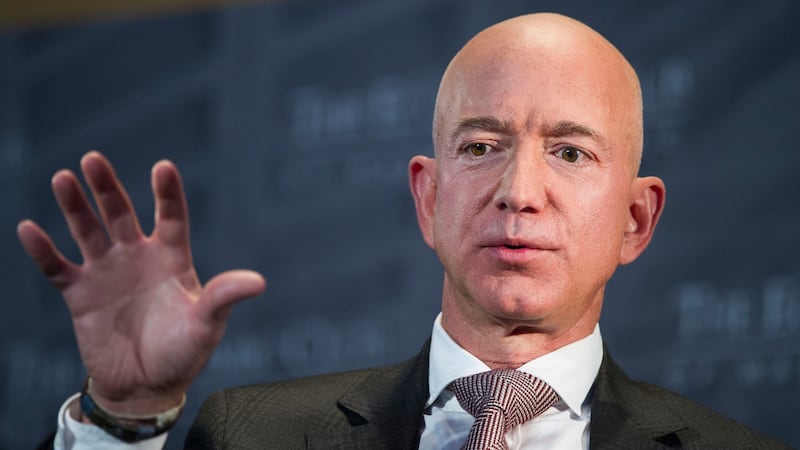A few hours after Amazon announced it would raise the minimum wage for its US staff to $15 (€13) an hour, chief executive Jeff Bezos appeared on stage in Washington DC.
He was being honoured for his contributions to the US government, through Amazon's cloud computing services and his space exploration company Blue Origin.
Asked about Amazon, which has taken increasing fire over its dispassionate business practices as its market capitalisation touches $1 trillion, Mr Bezos was largely unrepentant.
“If you are going to do anything new or different it is going to be misunderstood by critics,” he said, adding that when you believe criticism is unfounded “then no force in the world should be able to move you”.
On pay, he conceded that Amazon, which is the second largest employer in the US after Walmart, initially wondered why it was being singled out, compared with fast food companies or coffee chains. In the end he said that, trying to be “competitive” on pay compared with other retailers, it had “decided to lead”. “I think people will follow.”

It was a canny political performance. While Google, Facebook and Twitter have recently found themselves scrambling to contain political eruptions Amazon, which has assembled the biggest lobbying team of any technology company in Washington, seems to be a step ahead.
Last month, after Amazon was criticised for quashing a new business tax in Seattle designed to address the city’s homelessness problem, Mr Bezos launched a $2 billion charity aimed at homelessness and education.
Now, Amazon's pay rise blunts growing discontent at working conditions in its network of logistics warehouses, as well as the push for unionisation among its employees - particularly at the retailer Whole Foods.
Both moves come ahead of the announcement, before the end of the year, of where Amazon will build its second US headquarters, where 50,000 people will work. Cities and states have rushed to offer billions of dollars in tax breaks and other subsidies to sweeten their bids, to the general dismay of observers.
Public relations victory
"This is a huge public relations victory - I would say it's almost a coup," said Anthony Chukumba, analyst at Loop Capital Markets. "Bernie Sanders is attacking Amazon, president Trump is frequently attacking Amazon, and this is Amazon improving their workers' lives."
He added that the higher wages would add between $900 million and $1.8 billion in annualised incremental costs in the US, less than 1 per cent of Amazon’s revenues.
Amazon has also reduced its seasonal workforce in the US by 16.6 per cent from 120,000 last year to 100,000 this year. In Dallas, it was advertising an hourly rate of up to $12.85 for a warehouse associate before the announcement, suggesting it is now offering them a 16 per cent rise.
As well as good politics, there were two pragmatic reasons for Amazon’s move. Not only is the labour market in the US tightening, but in the towns and cities where logistics hubs have emerged, at the intersection of major transport routes, the competition for warehouse jobs is particularly fierce.
Dave Lewis, chief executive of UK grocery market leader Tesco, said that average minimum pay rates at nine out of its 12 UK distribution centres were already ahead of Amazon's new UK minimum wage of £9.50 because of the competition for warehouse jobs. He said the rates would rise further in November. "If anything, they are catching up with us."
In areas where Amazon is not facing as much difficulty in recruitment, however, the pay rise does not apply. Amazon warehouse staff in Poland, Germany and Spain have taken industrial action in recent months at working conditions. Permanent staff in Germany can earn €12.22 an hour ($14.11) after two years.
Amazon is not stopping at increasing pay for its own workers. It said it would put its weight behind efforts to raise the federal minimum wage from $7.25, reframing itself from a target of labour activists to a leader of an issue that is gaining momentum across the country - and potentially increasing costs for its competitors.
"Amazon is setting a new national standard for what the wage should be for high school educated workers," said Michael Mandel, chief economic strategist at the Progressive Policy Institute. "This is going to force a lot of companies to decide if they want to start investing in their workers and investing in technology because they no longer want to be stuck in a low productivity, low wage equilibrium."
Genius move
"It's a genius move on three levels," said Gene Munster, a former Wall Street analyst turned investor at Loup Ventures. Most directly, the increase "motivates" its workforce, reducing costly turnover among the 250,000 US workers who will see their pay go up next month and helping to attract the 100,000 seasonal workers it plans to hire for the upcoming holiday season.
Amazon will also benefit from what he described as "the Henry Ford approach: if you put more money in your employees' pockets, they spend more money on your platform. It comes back to you."
And at a higher level, it allows the company to present a “more favourable” image to consumers and lawmakers. “As you become a bigger company, you become a bigger target. It helps to mitigate some of that risk,” he said. – Copyright The Financial Times Limited 2018











